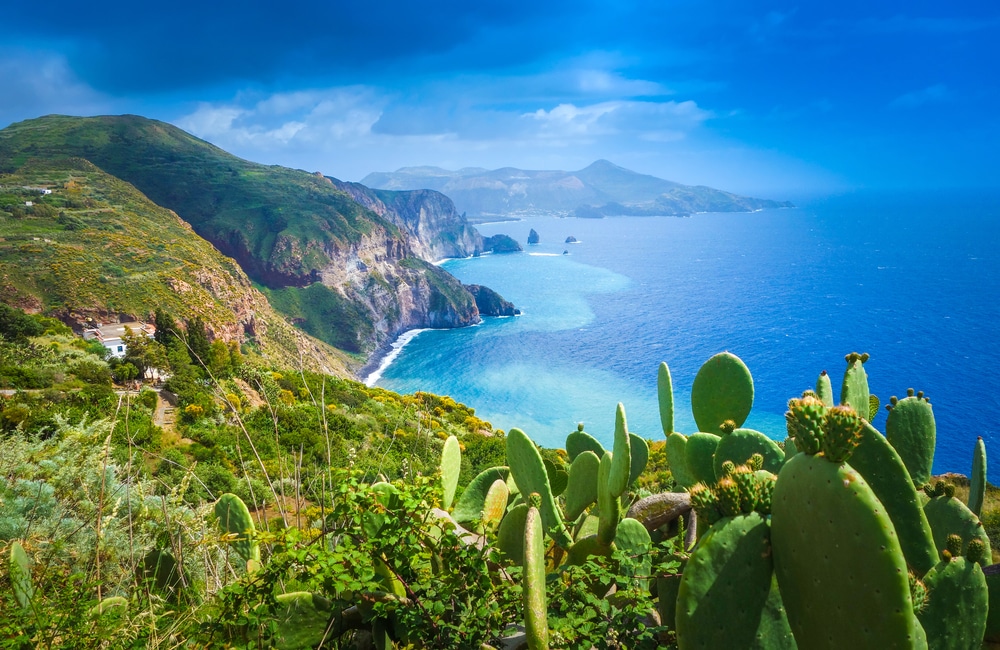Aeolian Islands – Twenty islands located just off the coast of Sicily and thus directly in the Mediterranean Sea. A barely touched landscape, hospitable people and the easy possibility to explore completely different areas of the Mediterranean from here.
These are the Aeolian Islands. It may be one of the last insider tips in the Mediterranean or even in all of Europe. The small group of islands, which lies off the northern coast of Sicily, consists of 20 small islands, but not all of them are inhabited. In recent years, the traffic with tourists has increased a bit and infrastructure has been created accordingly. Nevertheless, you still have the opportunity to explore this area in an almost untouched way.
Aeolian Islands – what makes them so special?
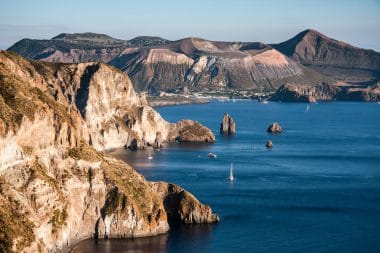
Only the seven main islands of the various islands are inhabited. For many centuries, the people here have lived mainly from fishing, a craft that has been preserved to this day, but which has shaped a lively exchange with their brothers and sisters in Sicily. As is so often the case in this area, the archipelago was formed with the help of volcanoes. In fact, the Aeolian Islands are still home to the last regularly active volcano in Europe, which always poses a small, if not great, threat to the inhabitants.
In the tongue of the inhabitants of Sicily, the group is also called the Aeolian Islands. This is because, according to a legend, the gods of the wind were once here. If you look at the many shipwrecks that have accumulated around the islands, you can at least believe the assumption that there can be a very strong and, above all, dangerous wind here.
Of course, these are no longer a real threat to today’s ferries. Outside the winter months, the islands are visited several times a week, in the summer months there is a regular transport that runs several times a day and can take holidaymakers to the most important islands of the group.

The special feature is that the seven islands are also very different from each other. Each of them has its own magic to offer. What unites them above all is that tourists are welcome here. In addition, the islands are frequented by a wide variety of travelers. Divers and adventurers will find just the right basis for their activities, people looking for peace and relaxation benefit from the fact that there are hardly any roads and even fewer cars on the islands. So nothing stands in the way of a quiet day at the beach.
Life and holidays in the Aeolian Islands
Basically, when visiting the Aeolian Islands, you should take the opportunity to explore each of the inhabited islands. They all offer their own charm. Since there are only a few accommodations to be found here, there are not too many tourists. So you have all the time in the world to get an overview and plan the day for a wide variety of activities.
Lipari
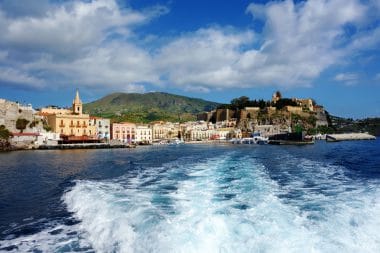
The main island of Lipari is also the most important place on the archipelago. Most ferries dock here and most tours start from here. The island is still the most likely to be developed for tourism and also offers sufficient help for planning. Special tip: The bay of Canneto with many opportunities for diving and swimming. The old town is also worth more than just a look. This is a great place to spend the day.
Detailed information about Lipari can be found in our detailed article: https://reisemagazin-online.com/lipari-kein-traum-sondern-eine-trauminsel/
Highlights on Lipari
- Archaeological Museum of Lipari: One of the most important museums of the history of the Mediterranean, housed in the impressive castle complex of Lipari. It presents finds documenting the rich history of the Aeolian Islands from prehistoric to Roman times.
- Lipari Castle (Castello di Lipari): The historic fortress that houses the Archaeological Museum offers impressive views of the surrounding area in addition to the exhibitions.
- San Bartolomeo Cathedral: A beautiful church within the castle walls, dedicated to the patron saint of the island, known for its ornate frescoes and religious artwork.
- Marina Corta: The picturesque port of Lipari is a lively meeting place with cafes, restaurants and a beautiful view of the sea. Ideal for a relaxing walk or to start a boat trip to the other Aeolian Islands.
- Beaches of Lipari: The island offers numerous beautiful beaches such as Canneto, Bianca and Spiaggia Valle Muria, where you can swim, sunbathe and enjoy the natural beauty of the surroundings.
- Thermal Springs of San Calogero: A historic thermal bath complex that has been used since ancient times and whose mineral-rich waters are known for their healing properties.
- Obsidian and pumice quarries: Lipari is famous for its deposits of obsidian and pumice. Visitors can explore the impressive quarries and learn more about the geological history of the island.
- Largest island in the archipelago
- Area: approx. 37.6 square kilometres
- Highest point: Monte Chirica, approx. 602 metres
Salina – the green island
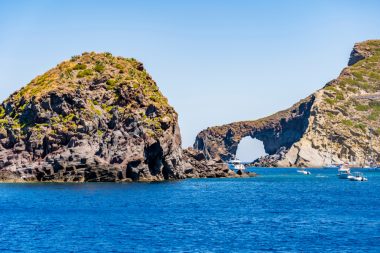
Salina is best known for its vineyards. Dominant are the two huge hills on the island, the many vineyards and it is not for nothing that it is called the green island. Guided tours lead across the island. Friends of the culinary arts in particular will get their money’s worth here.
Popular excursion destinations on Salina
- Monte Fossa delle Felci: With an altitude of 962 meters, this is the highest point of the Aeolian Islands. A hiking trail leads to the summit, from where you can enjoy a breathtaking view of the archipelago and the Tyrrhenian Sea.
- Wine tastings and vineyard tours: Salina is famous for the production of the sweet Malvasia wine. Visitors can tour local wineries, participate in wine tastings, and learn more about winemaking.
- Pollara: This picturesque town was made famous by the film “Il Postino”. The cliffs and crescent beach offer spectacular sunsets and are a must-see for photography enthusiasts.
- Capo Faro: The Capo Faro lighthouse is a popular viewpoint that offers sweeping views over the sea to the other Aeolian Islands.
- Lingua Salt Lakes: A visit to the salt lakes near the fishing village of Lingua is recommended. Here you can also visit the small salt museum and enjoy the local specialty, granita, in one of the beach bars.
- Church of San Lorenzo in Malfa: An example of the island’s religious architecture, this church offers a peaceful retreat as well as beautiful views of the surrounding area.
- Boat tours: A boat trip around Salina allows you to explore the coastal landscape, hidden coves and the water grottos of the island. Day trips to the neighboring Aeolian Islands are also possible.
- Beaches: Salina offers some of the most beautiful beaches in the archipelago, including Rinella and Pollara, where visitors can swim, sunbathe, and relax.
- Known for its lush vegetation and Malvasia wine
- Area: approx. 27 square kilometres
- Highest point: Monte Fossa delle Felci, approx. 962 meters
>> Here you can find detailed information about Salina
Vulcano
The name of the island of Vulcano is no coincidence. During a hike across the island, it can happen that smoke or heat rises from a crevice. This is because the island was formed on a huge active volcano. With a hike to the crater, you can get an overview of the breathtaking landscapes.
- Known for its active sulphur fumaroles and thermal springs
- Area: approx. 21 square kilometres
- Highest point: Gran Cratere, approx. 500 metres
What should you definitely do when visiting Vulcano?
- Gran Cratere: The ascent to the Great Crater of the volcano is a must for every visitor. The ascent, which takes about an hour, rewards spectacular views of the surrounding islands and insights into the volcanic activity with sulfur vapors and fumaroles.
- Sulphur mud baths (Fanghi di Vulcano): The natural mud pools, rich in sulphur and other minerals, are known for their therapeutic properties. A dip in these waters can help alleviate skin problems and promote overall well-being.
- Black sand beaches: Vulcano is home to impressive black sand beaches, such as the Spiaggia di Ponente, which were formed by volcanic activity. These beaches offer a unique sunbathing and bathing experience.
- Vulcano’s thermal springs: In addition to the mud pools, there are also natural thermal springs whose warm water comes directly from the volcanic underground, ideal for relaxing after a hike.
- Valle dei Mostri: Called the “Valley of the Monsters”, this area offers interesting volcanic rock formations that have taken on bizarre and fascinating shapes due to erosion, reminiscent of mythical creatures.
- Boat trips around the island: A boat tour around Vulcano allows you to discover the impressive coastal landscape, including the Faraglioni (rock needles), the Grotta del Cavallo and the pool of Venere.
Stromboli
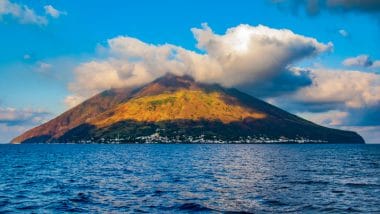
Stromboli was also built on a volcano. The difference is that it is actually active and not just slumbering on the island of Vulcano like its brother. The main town of the island is correspondingly small, as an eruption must be expected again and again. Anyone who takes the trouble to climb the strenuous ascent to the active crater with a mountain guide will have a unique experience. But the characteristic lava flows of the volcano can also be found everywhere else on the island.
Activities on Stromboli
- Stromboli Volcano: The main attraction of the island is the active volcano Stromboli, one of the few volcanoes in the world that shows continuous explosive activity. A guided hike to the crater offers the opportunity to observe spectacular eruptions from a safe distance.
- Sciara del Fuoco: This “fire canyon” is a large, sloping scree slope on the northwest side of the volcano, over which lava and pyroclastic material slide into the sea. For the best views of the nightly eruptions, take a boat tour along the Sciara del Fuoco after dark.
- Beaches of Stromboli: The island offers several black lava sand beaches that allow a unique bathing experience in the shadow of the volcano. The Ficogrande beach and the beach of Piscità are particularly popular.
-
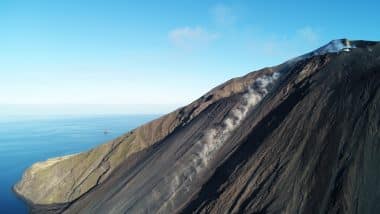
Sciara del Fuoco, the fire school on Stromboli, Image: Angelo Gitto / shutterstock Stromboli by Night: A boat trip around the island after dark to observe the volcanic eruptions from the sea is an unforgettable experience. The glow of the lava exploding into the night is a fascinating sight.
- San Vincenzo Church: This small church not only offers a spiritual retreat, but also a beautiful view of the sea and the volcano. It is a popular photo spot with visitors.
- Hiking and trekking: In addition to the hike to the volcano, Stromboli offers numerous hiking trails that lead through the picturesque Mediterranean vegetation and offer breathtaking views of the sea.
- Centro Visitatori Stromboli: A visitor center that provides information about the volcanic activity, the geological history of the island, and the local flora and fauna.
- Ginostra: A small village on the opposite side of the volcano, accessible only by boat, offering a quieter, more secluded atmosphere.
- Astronomical observations: Due to the low light pollution, Stromboli offers ideal conditions for stargazing, especially in the summer months.
- Famous for its active volcano that shows regular eruptions
- Area: approx. 12.6 square kilometres
- Highest point: Stromboli (volcano), approx. 926 meters
Filicudi
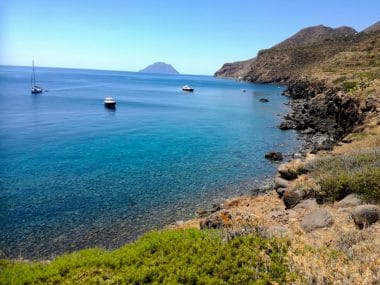
Filicudi is the paradise for divers par excellence. Over the centuries, it has become an amusement park for those who seek their fortune under the water. Wrecks and accumulations of old relics can be found everywhere. In addition, the tours lure you into the small bays and caves of the island, which are so typical of the Aeolian Islands.
- Characterized by prehistoric settlements and spectacular rock formations
- Area: approx. 9.5 square kilometres
- Highest point: Fossa Felci, approx. 774 metres
Alicudi
If you are looking for real seclusion on holiday, Alicudi is the right place for you. There are no hotels, bars or clubs. Instead, there are a small number of private holiday apartments. If you want to spend your holiday in peace and quiet in this special climate and on the islands, this is the place for you. Not only is it possible to explore all the other islands, but Alicudi itself also offers some true natural beauties.
- The least developed and most remote island, known for its tranquil atmosphere
- Area: approx. 5.2 square kilometres
- Highest point: Filo dell’Arpa, approx. 675 metres
Panarea
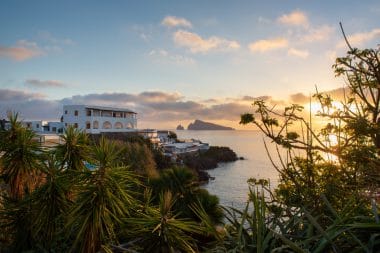
Panarea is the counterpart for people with a big wallet. In summer, yachts of various sizes can be found here and stars and starlets also travel here, as they also appreciate the magic of the Aeolian Islands.
- The smallest and most exclusive island in the archipelago, popular with the jet set
- Area: approx. 3.4 square kilometres
- Highest point: Punta del Corvo, approx. 421 metres
So the Aeolian Islands are one of the last real insider tips for travelers in Europe for a reason. With its diversity and the many different things to discover, the holiday offers just the right holiday destination for divers, adventurers but also for those who are looking for a little retreat from everyday life.
Weather in the Aeolian Islands
The Aeolian Islands enjoy a typically Mediterranean climate, characterized by mild, humid winters and hot, dry summers. The following climate table provides an overview of the average temperature and precipitation values based on general climate data. It is important to note that these values represent averages and actual weather conditions may vary.
| Month | Average maximum temperature (°C) | Average low temperature (°C) | Average rainfall (mm) |
|---|---|---|---|
| January | 13 | 9 | 76 |
| February | 13 | 9 | 64 |
| March | 15 | 10 | 57 |
| April | 18 | 12 | 42 |
| May | 22 | 16 | 25 |
| June | 26 | 20 | 15 |
| July | 29 | 23 | 5 |
| August | 30 | 24 | 15 |
| September | 27 | 21 | 40 |
| October | 23 | 18 | 72 |
| November | 18 | 14 | 98 |
| December | 14 | 10 | 93 |
This table shows that the Aeolian Islands are characterized by warm summers and mild winters, making them an attractive destination all year round. Summer is the driest time of the year, ideal for beach holidays and outdoor activities. The winter months bring more rainfall, but still offer pleasant temperatures for sightseeing and hiking tours. The transitional periods of spring and autumn are particularly attractive, with pleasant temperatures and lower visitor numbers.
How to get to the Aeolian Islands?
To travel to the Aeolian Islands, there are different options depending on where you start your trip from. The islands are not directly accessible by plane, so the journey is usually a combination of flight and ferry. Here are the common ways to get to the Aeolian Islands:
1. Arrival via Sicily
Most travelers reach the Aeolian Islands via Sicily. The main ports of departure are Milazzo, Messina, and Palermo.
- Milazzo: This port offers the most frequent and fastest connections to the islands and is the preferred starting point for trips to the Aeolian Islands. There are regular ferries and hydrofoils operated by various shipping companies.
- Messina and Palermo: There are also connections from these cities, but less frequently than from Milazzo.
2. Arrival via the Italian mainland
For travelers starting from the Italian mainland, traveling via Naples is an option.
- Naples: From here there are ferry and hydrofoil connections to the islands, but they take longer than the connections from Sicily.


